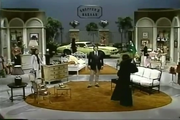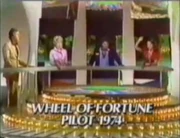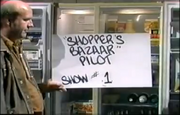
The beginning of the beginning.
Prior to becoming a series, Wheel of Fortune recorded a number of pilot episodes. These are a common feature of the television industry, particularly game shows, as they allow producers and showrunners to test the show's viability and have a product presentable to potential buyers. This page documents not only the pilots themselves, but any known events related to them.
Despite their importance and the fact that copies exist in the Sony archives, Wheel itself has largely ignored its pilots. Clips of 1974 Pilot #1 were shown during the ceremonial 3,000th nighttime episode on November 20, 1998, which claimed it was the pilot.
1973 or 1974: Runthrough[]
At some currently-indeterminate point, a development runthrough is shot by Merv Griffin Productions.
- The runthrough is hosted by Merv, reading the rules off a set of papers in his hand. The available footage does not indicate whether there was an announcer.
- The set consists of the Wheel at center stage, with the contestant area to the left and the puzzle board to the right. The players sit at a desk, while Merv stands to the left of the Wheel. The set layout may suggest having been recorded in New York, as it is basically identical to a "flipped" version of the Shopper's Bazaar set layout and numerous game shows.
- The Wheel is a much smaller version of the one used in the Bazaar pilot. The layout consists of various cash amounts from $5 to $500, three Lose a Turn spaces, and one each of Buy a Vowel and Free Spin.
- Two other spaces appear once each, but the available footage does not explain them. One is Bonus, which may be a variant of Free Vowel or an early Prize wedge: the other appears to be Add A (telephone symbol), which is most likely a variant of Your Own Clue.
- The Wheel is spun by Merv by hand, going counterclockwise as in Bazaar.
- The puzzle board consists of three rows of 12 spaces each and letters revealed by pull-cards. The spaces for unrevealed letters are denoted by a white line on the top or bottom. A curtain or similar material is removed from the board to reveal the puzzle at the start of each round, and incorrect letter calls are denoted by a series of three honks.
- As with the Shopper's Bazaar pilot, puzzles are either Person, Place, or Thing.
- During the runthrough, Merv says "Wheel of Fortune spins, and where it stops nobody knows." Given the available footage and the uncertainty of when this runthrough was recorded, it is currently not known whether Merv was referring to the show by name, or just the centerpiece by name - and, by extension, whether this was recorded before or after Bazaar.
The runthrough appears to have remained well under the radar until October 2017, as its existence was not known about by the fan community until clips appeared during the Buzzr documentary Game Changers. The fact the footage is in black-and-white, with a bit of blur, may suggest a film source.
Fall 1973: Shopper's Bazaar[]
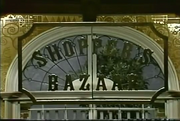
A bizarre bazaar.
Taped in September or October 1973 (the show's E! True Hollywood Story mentions September, whereas the UCLA Film & Television Archive's listing for the pilot is dated October 8) for NBC at the request of Lin Bolen, the network's then-vice president of daytime programming.
- The show is hosted by Chuck Woolery, with announcer Mike Lawrence. Two female models are also present (one Caucasian, the other African-American), but they do not appear after the opening segment and are not listed in the credits; the latter bears a resemblance to Harriet, a model who appeared in early nighttime episodes of The New Price Is Right the previous year.
- Bill Carruthers is producer and director.
- The main theme is an instrumental version of "Chitty Chitty Bang Bang" by Richard M. Sherman and Robert B. Sherman (released in 1968). An instrumental version of "Spinning Wheel" by Blood, Sweat & Tears (released in 1969) is used for commercial outros and the post-Round 4 prize tally. The use of well-known music was common in game show pilots during the 1970s-80s, with those that went to series often using a soundalike piece.
- The Wheel, designed by Spencer Davies and based heavily on those used in various casinos, is vertical and mechanical with 30 wedges.

Rounds 3-4 Wheel.
- The Wheel has two Lose a Turn wedges (with two more added for Rounds 3-4) plus one each of Buy a Vowel, Free Spin, Free Vowel, and Your Own Clue. Cash amounts range from $0 to $500 (in Rounds 1-2) or $1,000 (Rounds 3-4).
- Landing on Free Spin gives that player a thin white disc with "Free Spin" in black on a yellow background, which may be turned in if that player calls a wrong letter or lands on Lose a Turn.
- Despite the presence of Buy a Vowel, contestants may buy vowels at their discretion for $250.
- The Wheel is halted by Chuck pressing a button once the player in control yells "Stop the Wheel!", which makes the arrow above the Wheel come into contact with the spokes (although the Wheel occasionally resumes spinning almost immediately after stopping).
- Presumably to better show the general gameplay, the layout used for the opening segment (see below) has no special spaces, and the values range from $50 to $450 in multiples of $50.
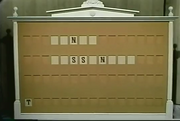
- The puzzle board is brown, with three rows of 15 spaces each and letters (in the Hopkins font, also used for the logo) revealed by pull-cards, with a staff member clearly visible behind it. A fourth row serves to denote letters that are called but not in the puzzle, referred to here as the "Wrong Letter Board" in lieu of an official name.
- Correct and incorrect letters are denoted by an electronic-sounding bell and buzzer; the latter is also used for Lose a Turn, while a set of six bells notifies the players when only vowels remain. The player who solves the puzzle also starts the next round.
- Three categories are used: Person, Place, and Thing. While Chuck brings this up at the start of each round, the specific category is only given through Your Own Clue.

Look at this consignment shop!
- The set resembles an antique store, with the prizes strewn about along with other items (including picture frames on the back walls) and wood paneling. Chuck's area is a thin podium with an angled surface. The contestants, all female, sit at individual chairs behind a short table (a single three-cushion couch during the opening segment). The table itself has a white rotary phone on top, which is used for Your Own Clue.
- The opening begins with a close-up of the show's logo as Lawrence says "You are at the Shopper's Bazaar. These ladies have been shopping and selecting gifts from our boutique to play for in our game today." The contestants are introduced one at a time, and Lawrence gives a brief description of the three prizes she has selected followed by her grand total; following this, Chuck asks her to stop the Wheel, and once it does she picks a consonant for the Round 1 puzzle.
- The process repeats with the other two players, with the back of the set splitting apart (and the logo raising up) to reveal Maureen's last choice: a 1974 Pontiac Firebird. After the third letter call, Lawrence says "That's how our game is played! And now, here is the host of the Shopper's Bazaar: Chuck Woolery!"

The Accounting Department.
- Prizes and contestant winnings are handled by an "Accounting Department", an offstage board of three columns with four squares each which lists the three prizes each contestant chose before the taping and their values. Below these cards are flip displays showing how much that player has earned toward winning it, while above the top prize is each player's name and the total value of their prizes. While all three players' money carries over from round to round, with winnings being applied to the next prize once one is covered, a contestant can only "bank" the money if she solves a puzzle; should she do so and have enough to buy a prize, she wins it (a star appears on the far right of that prize's flip display, and the square itself is lit up). The board is shown on-camera after each round to update the scores.
- Contestants who do not win any prizes receive a Magnavox black-and-white TV as a consolation prize.
- The winner (determined by how many prizes she wins, not how much money she accumulates) plays a bonus puzzle called "Shopper's Special": the player is shown all vowels in the puzzle (also the name of the prize she is playing for), then has 30 seconds to give one correct consonant and subsequently solve the puzzle. The timer cue is Merv's "A Time For Tony", cued up at the 1:20 mark (appropriately, a ticking section). An unknown cue is used while the bonus prize is described.
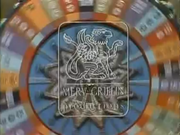
- The credits, also in the Hopkins font, scroll vertically with the name in all-caps below their credit. The credit roll ends with the Merv Griffin Productions logo, albeit an entirely new design rather than the one then in use on Jeopardy!: a transparent white vertical rectangle with rounded corners, containing a drawing of a griffin over "MERV GRIFFIN productions", which scrolls up at the end of the credits over the spinning Wheel for the last few seconds. This version, also used on the subsequent two pilots (but notably not on the nighttime version of Jeopardy! that would launch in 1974), becomes the company's main logo in 1975 and remains (with minor adjustments) through about November 25, 1983; the griffin itself is retained until June 1994.
- There are no fee plugs, sponsor lists, eligibility disclaimers, or wardrobe credits.
- On the pilot itself (Marilyn/Dawn/Maureen):


- The slate (a piece of poster board held by a stagehand in front of the on-set refrigerator/freezer combo) does not include a recording date, only saying "Shopper's Bazaar Pilot Show #1" with the show's title in quotation marks. It is very likely that there were no subsequent tapings, as explained below.
- The first puzzle is HENRY KISSINGER, who was sworn in as Secretary of State on September 22, 1973. This would suggest that Bazaar was taped within a few days of the event.
- The first wedge landed on is $100, and the first letter revealed is S. The first incorrect call is T, which does not appear in any of the puzzles.
- As Maureen is introduced during the opening, she is shown next to a clock displaying a time of 6:40.
- The first vowel bought is I, by Marilyn in Round 1, though only $150 is deducted from her score.
- During Round 2, as Maureen debates over what to do, Chuck says "Quickly, or we'll be into Search for Tomorrow" despite the fact that it airs on CBS at this point (although it moves to NBC in March 1982). Amusingly, one player says "Search for Tomorrow?" a few seconds after Maureen opts to stop the Wheel, to which Chuck replies "I don't know."
- Chuck's comment may also be an indirect reference to the fact this is a pilot, since pilots by their very nature are on a "search for tomorrow" (going to series, thus having a proper "tomorrow") and game shows which do multiple pilots tend to not have continuity between them, including Wheel itself (two known exceptions are the 1973 version of Match Game and the 1982 show Child's Play, where in both cases the second pilot continued directly from the first).
- Marilyn lands on Free Spin in Round 3, but continually opts to save it. She ends up losing the game.
- After the Round 4 puzzle is solved, the stagehand behind the puzzle board accidentally pulls up the last letter card while revealing it.
- Lose a Turn and Free Vowel are hit four times each. Interestingly, Buy a Vowel is not hit.
- Although $0 is hit three times, no correct letters are called for that amount.
- Following the Shopper's Special, Chuck says "We'll be back tomorrow with three new contestants!" Papers detailing the Bazaar format mention returning champions, although it is not certain whether this element was dropped by the time of taping or only applied if the winner lost the Shopper's Special.
When shown to test audiences, the response is that of unenthusiasm: they do not understand the gameplay nor why players have to buy vowels, cannot see the puzzle board, and call the game "very slow" and "not challenging". The viewpoint is shared by Bolen (who called Bazaar "old-fashioned", particularly in regard to the set) and Merv (who simply said that "Everything about it was wrong."). A further problem is that discounting the slate, the pilot runs a staggering 30½ minutes, and there is no indication that the show was intended for anything larger than a standard half-hour timeslot. Given the aforementioned, it is uncertain whether the pilot was ever shown to or discussed with Bolen's higher-ups at NBC. One of the most well-known industry-related publications of the era, Variety, only mentions the original title a single time (see "July 1974"); another, Broadcasting (now Broadcasting & Cable), does not mention the show at all.
Prior to May 30, 2012, when the opening segment surfaced on YouTube, no footage of Bazaar is known to have appeared anywhere in any way, with it instead being represented by approximately four publicity shots (one in color) in various places including the aforementioned True Hollywood Story. While Game Show Network is known to have a copy and has aired numerous pilots, they have not shown Bazaar, possibly due to music rights.
July 1974[]
- On July 31, the daily edition of Variety publishes a brief report from Murray Schwartz (then-president of Merv Griffin Productions) that the company will produce "a new game show pilot for NBC". The report then notes that the upcoming pilot is "tentatively titled" Shopper's Bazaar, discounting the actual pilot of that name entirely.
- The United States Patent and Trademark Office lists the "Wheel of Fortune" trademark (serial number 73656614 and registration number 1491571, filed in April 1987 and registered in June 1988) as having a "first use" date of June 1974 and a "first use of commerce" date of January 6, 1975. While the latter is accurate, the former appears to suggest that Merv Griffin Productions was already leaning toward changing the show's title, which may be related to the aforementioned runthrough; alternatively, the "first use" date is a typo and should really be August 1974, which would line up with the aforementioned Variety report.
August 1974: Wheel of Fortune Pilots[]
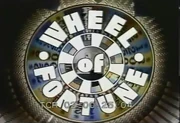
The more things change...
A further two pilots were taped August 28, 1974 for NBC. Nearly everything associated with the 1973 attempt was altered in some way or simply removed.
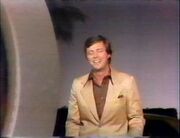
Changes include:
- The show is renamed Wheel of Fortune, complete with a new logo.
- Edd Byrnes and Charlie O'Donnell replace Woolery and Lawrence.
- The show's theme song is changed to "Give It One", composed by Maynard Ferguson and Alan Downey, from Ferguson's 1972 album M.F. Horn Two.
- The Wheel is redesigned by Ed Flesh to be horizontal and spun by the contestants (using the pegs), with much larger wedges (24 in total). Free Vowel, Your Own Clue, and $0 are retired, while Lose a Turn is pared down to just one wedge and Bankrupt is introduced. The minimum is now $25, and the top amounts are changed to $350 for Round 1, $500 for Round 2, $750 for Round 3, and $1,000 for Round 4. The center of the Wheel is light green and allows for chroma-key effects, such as changing color for every spin.
- While the wedges are still separated by pegs, each individual wedge now has two pegs in the middle, dividing them into thirds.
- The font for the dollar signs, numbers, and letters is changed to Fortune Extrabold (also known as Chesterfield).
- The "pointers" (see below) are flimsy, and as a result the Wheel is extremely loose, despite a prop man being underneath (lying on his back with a TV monitor nearby). The prop man nearly faints from this, resulting in the inclusion of air conditioning and a fan.
- Buy a Vowel is added in Round 2, with a second wedge added in Round 3. A second Bankrupt and another Lose a Turn are added for Round 4, replacing Free Spin in the process. All four special spaces have white outlines (with the odd exception of Free Spin in Round 2), and all except Bankrupt have white outlines around the letters.
- The special spaces are kept at an equal distance from each other (apart from two of them being separated by three cash spaces and the others being separated by four in Round 3). The number of these spaces starts at three and increases by one every round.
- The Wheel also shows a pattern of having the largest value(s) clockwise of Bankrupt and the smallest value(s) counterclockwise of Bankrupt, as well as the second-largest value(s) clockwise of Lose a Turn and the second-smallest value(s) counterclockwise of Lose a Turn. $50, the smallest value in Round 2, is also the smallest value in Round 4 despite $100 being the smallest value in Round 3.

Pilot #1.
- The puzzle board is also redesigned by Flesh to be much larger and gray, with 39 trilons on three rows and a single light border, a prop which slides onstage at the start of each round. The trilons show green mosaic tiles for unused spaces, a solid white for unrevealed letters, and black letters on a white background. Correct and incorrect letter calls are signified by a ding and buzzer, respectively; correct letters light up the border plus all of that letter's instances at once.
- In the event that only vowels remain in the puzzle, eight high-pitched beeps are heard.
- Once a puzzle is solved, all unrevealed letters light up and turn around to a portion of "Give It One". As with Bazaar, the player who solves the puzzle spins first in the next round.
- While the puzzle board is designed to be motorized, this element is not completed by the time of taping. A portion is finished, but these are gutted out so the trilons can turn freely; Susan Stafford is hired to turn the letters.
- Edd notes at the beginning of the game that each puzzle is a Person, Place, or Thing, then gives a clue for each round (for instance, the first puzzle of Pilot #2 is "a popular television actor").
- The host/contestant area is overhauled:

Pilot #1.
- The players now stand. Behind them are three pillars with the same green mosaic tiles as the unused trilons and a white display showing money put "on account", with an "ON ACCOUNT" light above the display. The display shows up to four digits plus a dollar sign, omitting the latter if $10,000 or more is put on account.
- A white railing is in front of the players and host at about hip level, which is curved around at the host's area. Attached to the railing at the host's area is a container with a stack of Free Spin discs, which are now tan with "FREE SPIN" written in white characters in the middle.
- Below the railing at the contestant area is a set of three black displays used to denote score during puzzles and cumulative totals after Rounds 2+ (both in a white Eggcrate font), with the same limitations as the displays behind them. These main displays are placed above large arrows which flash for each contestant's turn, and at the end of each arrow is a thin, flat "pointer" used to (ostensibly) slow the Wheel to a stop and denote what space that player has landed on. The arrows are red, yellow, and blue for the first, second, and third players respectively.

Pilot #2.
- Contestants now purchase from a "showcase" of prizes located behind the puzzle board, which moves away so the player can shop. Both pilots use the same prizes, with their names and values scrolling vertically on the left side of the screen; a "SOLD" tag marks prizes already purchased.
- After solving one of the first three puzzles, players may opt to put those winnings on account immediately or go shopping. Round 4 is always followed by shopping, with any remaining money likely placed on a gift certificate (as there is a gift certificate prop among the prizes).
- As Charlie describes the shopping prizes, the background music played is "Cinnamon and Clove", composed by Johnny Mandel and performed by Pat Williams.
- The Wrong Letter Board and Accounting Department are combined into a single chalkboard with 26 flip-up cards on top. The cards are flipped back once a letter is called, becoming a true "Used Letter Board", while the chalkboard itself is used to show the players' names and keep track of both their current and cumulative scores (with a separate section denoting money put on account). The chalkboard, like the Accounting Department, is placed offstage; unlike the Accounting Department, the Used Letter Board is almost never shown on-camera.
- The intro begins with Charlie mentioning several prizes as they are shown (specifically, "A spinet piano, a trip to Las Vegas, a Muskin Dune Cat, a 24-inch color TV, a 1975 automobile [more specifically, an Opel], or a Snark sailboat!"), followed by a wide shot which is chroma-keyed into a slowly zooming-out shot of the Wheel. Charlie continues with "These are just some of the many exciting prizes available. Total retail value of all these prizes: $20,130! Yours to buy today on Wheel of Fortune! And now, here's your host: Edd Byrnes!"
- The 2:33-3:10 portion of "Give It One" plays, with the last note of the song edited in.
- As Charlie says "all these prizes", the money graphic (using a tall, thin font) appears.
- At "host", the shot zooms back in through the Wheel as Edd walks out. He then introduces Susan, who walks up from the contestants' left holding an ECM-51 microphone and introduces the players as their backdrops light up (over another portion of "Give It One").
- The final segment consists of Edd recapping the scores, announcing the winner, and talking briefly with Susan as an unknown cue plays. As they sign off, Edd spins the Wheel as it zooms back into view with the two in the center, and as "Give It One" plays from the beginning. The chroma-key shot, which moves over to the prizes, continues through the credits (which are set in the Clarendon typeface) and as the Griffin logo appears.
- Losing players receive unstated parting gifts regardless of whether they solve any puzzles. Edd's phrasing suggests that the gifts are added to any prizes that are purchased during the game.
Other notes about these pilots:
- The staff credited on Bazaar is almost entirely replaced: not counting Merv, only John Lauderdale and David S. Williger are retained. John Rhinehart becomes producer, while Marty Pasetta directs. Among the production staff is Nancy Jones, who is promoted to associate producer when Wheel goes into series production (a late-1986 interview suggests Nancy was also present for Bazaar, although she is not credited there).
- Edd is drunk, as he would later recount in his autobiography Kookie No More. During both tapings, he says odd phrases like "Spin the puzzle and solve the Wheel" and generally makes it clear he is reading from cue cards. While he is noticeably more sober for Pilot #2, he is confronted after the taping by an upset Susan.
- While Edd changes suits between the pilots, Susan wears a single powder-blue outfit for both.
- There are no fee plugs, sponsor lists, eligibility disclaimers, or wardrobe credits.
- During the taping, Merv becomes upset that Pasetta includes shots of other things, demanding that Wheel be shot more like Jeopardy! Pasetta eventually retaliates to these demands by demanding that Merv be barred from the control room, a viewpoint shared by Bolen.
- On Pilot #1 (Marge/Gary/Roseanne):
- Edd makes faces at the camera at points, and during Round 1 mistakenly says the total of all the Wheel values is $435 rather than $4,225.
- The first wedge hit on the new Wheel is $200, and the first letter called on the new puzzle board is R. The first wrong letter called is T.
- During Round 1, the board and sound operators both mishear Gary's call of F as S (a call repeated by Edd even after the S's are revealed), although this is not noticed.
- There is a noticeable edit in Round 1: Roseanne and Edd can both be heard overreacting as the Wheel stops at $275, and there is a jump cut before Edd prompts her for a letter. It is likely from their reactions that they were both looking at Gary's arrow, which was on Lose a Turn.
- In the same round, Gary calls a repeated T, but it is only acknowledged as a wrong letter.
- Roseanne's nametag falls off on her first spin of Round 2. It disappears later in the round, but she does not wear it again until the start of Round 3.
- The first I in the Round 2 puzzle SIRLOIN STEAK does not light up after Roseanne solves. By the next shot, it is lit after Susan has turned the trilon.
- Edd's hint for the Round 3 puzzle MOTHER GOOSE is "a fictional character", resulting in the debut of Fictional Character.
- During Round 3, Roseanne opts to solve for $1,300 only to be pressured by Edd (yelling "No don't guess, it's too early! Look at all the money you can make, you can make thousands of dollars! Be a gambler!") into spinning again. She solves one turn later with only the T, H, and R showing.
- During Round 4, after Marge hits $900 for the second time in a row, Edd tells her "I think you've fixed the Wheel!", an ironic statement given the show was using a prop man to stop the Wheel with his feet.
- Shortly after the above, Marge is given $750 for two R's rather than the proper $700. This does not appear to affect the outcome.
- None of Bankrupt, Buy a Vowel, or Free Spin are hit, and no vowels are bought.
- Despite Marge being called the returning champion by Edd at the top of the show, no cumulative total is shown or mentioned in the final segment.
- On Pilot #2 (Tanya/Frank/Lois):
- The lighting is a bit darker during the opening, most noticeable on the overhead Wheel shot.
- Edd makes noises as the Wheel spins, and during Round 1 mistakenly says the total of all the values is $4,335 rather than $4,225.
- Tanya had previously been a model on The New Treasure Hunt the previous year. This is not surprising, however, as game show pilots have typically used actors or professional contestants to play the game.
- During Round 1, Tanya is given $775 for three Ls rather than the proper $675 due to a mathematical error by Edd. The display initially shows the proper score of $1,375, but is "corrected" to $1,475 almost immediately afterward.
- Susan forgets to turn the last A in the Round 1 puzzle TELLY SAVALAS.
- During the shopping portion of Round 1, with $725 remaining to spend, Edd suggests Tanya buy a $660 brass bed, presumably because it is the most expensive prize she can afford at this point. Almost immediately afterward, after Tanya says she will buy the brass bed, he says "Are you sure? Don't let me talk you into it!"
- Although Tanya puts $25 on account after Round 1, her display is blank from the start of Round 2 onward.
- In what would become a rare occurrence, Lois spends all of her money in the Round 2 shopping segment.
- In Round 3:
- Buy a Vowel is hit once, by Lois.
- Lois calls a repeated D, but it is only acknowledged as a wrong letter.
- Despite Tanya having $25 on account from Round 1, and her main score display correctly showing $925 after solving Round 3 for $900, Edd only gives her $900 to spend in the Round 3 shopping segment. This leads to a discrepancy where Edd asks her if she wants to put $10 on account afterward, but her On Account display correctly shows $35.
- Once again, Tanya's On Account display is turned off at the start of Round 4, despite having $35 available.
- Tanya solves the Round 4 puzzle GERALD FORD ("a famous world leader") with only the Rs revealed. Just before this, when she indicates she wants to solve the puzzle, Edd says "I don't want to talk you out of this, but look at all the money you can make, you have so many empty spaces!" Tanya replies "I know, but look at all those Bankrupts!"
- Despite Tanya being called the returning champion by Edd at the top of the show, no cumulative total is shown or mentioned in the final segment.
- Following the full credit roll, Charlie says "Wheel of Fortune is a Merv Griffin production", which he did not say at the end of Pilot #1.
When shown to test audiences, the response is that the set is too busy, the sound effects are too noisy, and Byrnes does not fit. Bolen insists to her bosses at NBC that the show be picked up regardless, as follows: cancel Jeopardy! and give the remainder of its contract (scheduled to expire in January 1976) to Wheel, and if the new show fails she'll leave the network... but if it succeeds, she gets a raise.
November 1974[]
- By November 18, NBC agrees to put Wheel on the daytime schedule. It has been speculated by fans that the show being picked up because Bolen put her job on the line, rather than on its own merits, is a big part of why the pilots have almost never been brought up in an official capacity in the decades since.
December 1974[]
- On December 13, NBC announces that Chuck will be hosting the series instead of Edd. (It is rumored that Edd was caught reciting his vowels backstage by Merv.) The series begins taping shortly afterward.
- For at least the week of December 30, NBC airs two promos involving Wheel: one for the new game show lineup starting January 6 (including the debuts of Wheel and Barry-Enright's Blank Check), and one specifically for the debut of Wheel, both showing clips of the January 6, 1975 premiere. It is known that each promo aired on The Tonight Show starring Johnny Carson during the week of December 30 and the former aired on Tomorrow with Tom Snyder on January 2. Copies of both promos circulate among collectors.
